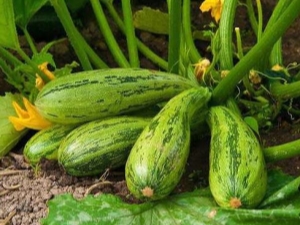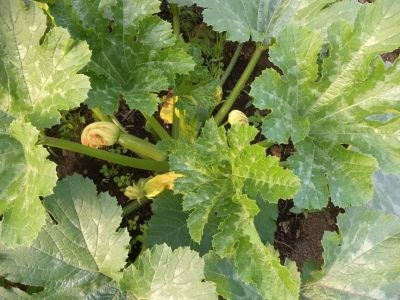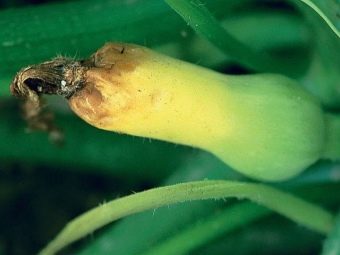Ways to combat diseases and pests zucchini

Squashes as well as other crops are susceptible to various diseases and are vulnerable to dangerous pests. In order to grow this plant, you have to work hard and make a lot of effort. To protect the zucchini from dangerous insects and diseases, you need to carefully examine the possible threats and take the necessary preventive measures.
Common diseases
Causes of zucchini disease can serve as various factors, but to combat them requires to know what is the current problem.
Mealy dew
This disease affects the squash leaves and after a short time can go to the petioles and stems. The main signs of infection are white spots appearing on the leaves and veins of the plant. Over time, they grow and connect into one big spot. After that, the sheet dries.
The causes of the disease can be:
- excessive moisture;
- too frequent feeding with nitrogen;
- poorly harvested soil in the autumn.
They fight disease with colloidal sulfur treatment. To prepare this solution will require 10 liters of water and 20 grams of colloidal sulfur.
Many also use sodium phosphate. It takes 50 grams of substance and ten liters of water.
If the plant has recently become infected, and the disease has not yet had time to develop, then you can burn the leaves with ground sulfur. In the fight and fungicides are useful, for example, "Topsin".
Downy mildew
This disease occurs on the leaves in the form of small yellowish spots. In the role of the pathogen is a fungus that forms a gray coating on the leaves. With the further course of the disease, the infected areas acquire a dark shade and the leaves fall off. The danger lies in the fact that if the disease is strongly neglected, the foliage may die completely, due to which the photosynthesis of the plant is disturbed.
Causes of appearance:
- excessive moisture;
- high humidity;
- poor soil care.
In order not to deal with the fight against this disease, it is necessary to take preventive measures, namely, to disinfect the seeds just before planting. This will prevent the appearance of peronosporoza on the site. It is also important to comply with all established agrotechnical rules, fertilize zucchini with essential minerals and supplements.
Do not be overwhelming and zinc or molybdenum solution. If the plant is still infected, it should be treated with potassium permanganate, at the rate of 2 grams per 10 liters of water. But this treatment will help only at the initial stage of infection.
Many carry out treatment with biologics or fungicides containing potassium. For such work, you can use Bordeaux liquid, copper oxychloride or the drug "Topaz". If the plant is already heavily infected, it is necessary to spray fungicides. For such work there is a certain scheme:
- spraying systemic fungicide;
- ten days later - contact fungicide;
- after five days - systemic fungicide;
- after ten days - contact fungicide and so on.
Anthracnose
This disease affects absolutely all organs zucchini. The most susceptible to him are those vegetables that are in the greenhouse or greenhouse. The main signs of infection are dark oval spots, as well as small brown specks with pink bloom. They are located mainly on the stems and flowers.
After a short period of time, the fruits rot, and small holes appear on the leaves. It is very important to notice this disease at the very beginning of its appearance, since with the defeat of the rhizome, it becomes impossible to save the plant.
The main reasons:
- excessive watering in hot weather;
- high air humidity or soil;
- poorly cleaned soil.
It is very important to take care of preventive measures prematurely, because curing zucchini from anthracnose is quite problematic. It is necessary to clean the site after harvest, destroying weeds. You should also remember the need for timely and moderate watering and regular weeding.
It is worth noting that the transfer of anthracnose can be carried out through the seeds, so seedlings should be selected for soil with special care. Seed treatment with a solution of boron or potassium permanganate will also be useful. When planting zucchini one must remember that in no case can they be planted on those plots where the pumpkin grew in the past season. These cultures are related, so they can be subject to the same diseases. Pathogens can remain in open ground and stay there for quite a long time.
If you ignore all the agrotechnical rules of sowing and care, you can put the plants in great danger and lose a significant amount of harvest. For watering squash leaves use special biological products, for example, Fitosporin. Processing should be done no more than once every two weeks.
If the plant is still infected and it is in the greenhouse, it is necessary to carry out a complete disinfection of the room using bleach. It will take two hundred grams of the drug to ten liters of ordinary warm water.
If the disease is in its initial stage, it is recommended to spray the Bordeaux mixture. And if the disease struck a large part of the garden, the squash should be destroyed.
Bacteriosis
Bacteriosis is one of the most dangerous diseases for zucchini. When running bacteriosis, you can lose a huge part of the crop and the plants themselves. This disease manifests itself through brown spots on the leaves. After the spots form huge holes, and soon the leaves wither. Further, it can be observed that the fruits are covered with dark ulcers.
The causative agent can enter the zucchini literally somehow - through insects, along with seeds, with water drops and post-harvest residues.
Factors in the development of the disease are:
- too sudden temperature drops;
- high soil moisture;
- infected seeds;
- post-harvest residues.
In order not to face long and difficult attempts to eradicate the disease, preventive measures should be taken. It is useful to carry out the disinfection of seeds with zinc solution. It is very important not to leave organically residues after harvesting the garden or harvesting, as well as to comply with all established agrotechnical rules.
Infected zucchini must be destroyed, and then to carry out treatment Bordeaux liquid. Fifteen days prior to harvest, the treatment should be discontinued.
White rot
This disease is characterized by white rot appearing on the leaves and fruits. These parts are covered with a fluffy white layer. A little later, you can see the black spores of the pathogen. Diseased areas become slippery, and after a while - die off. The harvest is two times less, and the taste of the fruit noticeably deteriorates.
Main factors:
- reduced temperature in combination with high humidity;
- poor cleaning and weeding the garden;
- a large number of dressings with nitrogen.
It is important to notice the disease in the first stages of its development, since in the future it will be extremely difficult to fight it. At the very beginning of the development of rot, the affected areas should be treated with a mixture of copper and chalk. Their proportions should be one to one. Some powder the diseased parts with crushed coal to stop the spread of infection.
If contamination has occurred in the greenhouse, then moisture should be reduced to prevent the massive spread of the disease. Watering should be carried out only with warm water.
Gray rot
In addition to white, there is also gray rot. It differs from white in that only young plants are subject to it.It affects the leaves and ovaries, because of what they become wet and slippery, and later covered with a bloom of gray.
Factors of occurrence:
- frequent temperature changes;
- high soil moisture;
- reduced soil moisture;
- cold water irrigation;
- high nitrogen content.
To get rid of gray rot, you need to regularly remove weeds, follow all established rules of care and planting, fertilize the plant with necessary dressings, and inspect it every ten days. Spraying the plant with iodine solution is also considered an effective option. In the presence of affected parts, they should be promptly removed.
Radical rot
The main sign of basal rot are constrictions on the roots. The roots and stems first darken and then rot. Infected zucchini can be determined by the size of the fruit: they are half the size of healthy vegetables, and the leaves become yellow. Gradually, the fruits begin to fall away, and in the end - the whole culture dies.
Causes of development:
- sharp temperature drop;
- affected cultures;
- the implementation of watering water temperature below 20 degrees;
- lack of proper care for garden beds;
- excessive feeding.
To prevent infection, prevention is needed. It includes the timely processing and watering of plants with warm water. When the first signs of infection appear, you should pour the soil to the stalk itself - this will allow you to form new roots.
Many spend spraying special drugs against rot.
All infected plants or their areas must be urgently removed and burned. And those areas in which they grew, it is necessary to process the copper sulfate.
Fusarium wilt
This is the most dangerous disease of all the previous, affecting the vascular system of zucchini and leading to their complete death. The initial symptoms include wilting of the leaves and stems too fast.
The main reasons:
- a large number of weeds in the area;
- crop residues remaining after gardening;
- neglect of the rules of crop rotation and agrotechnology.
Defeating fusarium wilt is possible only by eliminating all the factors that can develop the disease. If the infection started in the greenhouse, the soil needs to be replaced. You should also destroy absolutely all plants that may be infected.
Parasites
In addition to all existing viruses and diseases, there are also parasites that can cause irreparable damage to plants. It can be extremely difficult to get rid of them, so all preventive measures should be taken care of before the plant is attacked. Consider the most common and dangerous pests.
Spider mite
This insect is considered extremely dangerous and harmful to almost all cultures, and if it appeared on the site, it is worth sounding the alarm immediately. The body of this tick has an oval shape with a length from 0.3 to 0.4 millimeters. Tick eggs are spherical, green or transparent.
These parasites live on the underside of the leaves, where they weave their webs. Initially, small white dots form on the affected leaves, and then the leaf turns yellow and dries completely. Often happens the complete death of the plant. These mites feed on the cell sap of pumpkin or cucumber plants, which leads to abscission of flowers and leaves.
The appearance of these insects falls on the end of June. During this period, they breed hard. Wintering is spent at the very end of summer. It is carried out under fallen leaves, in various crevices, greenhouse frames or in the upper soil layer.
To combat this pest will need onion solution. This method is referred to as folk remedies. To prepare the solution, you need ten liters of water, one glass of carefully chopped onion, one tablespoon of crushed pepper, two tablespoons of wood ash and one tablespoon of liquid soap. All this is thoroughly stirred and sprayed the plants two or three times.The interval between spraying should be at least five days.
A good way is also the treatment with a solution of the Iskra preparation. It is necessary to dilute one tablet of Iskra in a ten-liter bucket of warm water. Ten meters of land use one liter of solution. Replacement "Iskra" can serve as the drug "Confidor". One milliliter means diluted in ten liters of water.
Gourd Aphid
This parasite is omnivorous and very often harms zucchini. Body shape is oval, color is green. Insect size - about one and a half millimeters. The larvae of this aphid can be green or yellow.
Reproduction is carried out in the spring, when the air temperature reaches 12 degrees. Affected leaves begin to curl and then fall away. Plant growth slows down.
When the pest first appears in the garden, control measures should be taken immediately. This may be spraying karbofos, for example. It is also very important to remove weeds, since it is on them that aphids develop in the summer period.
The affected areas of the plant must be burned. Spraying plants with ordinary water and pollination with crushed sulfur will not interfere. If the aphids in the garden are not very much, then you can do washing the plants with soapy water.
In rare cases, only a strong water jet is enough to knock off aphids from the plants. Zucchini can be protected from aphids with the help of the smell of garlic, fennel, mint, etc. It is necessary to plant these plants somewhere nearby.
White fly
This pest is the same as the previous aphid omnivorous. It brings particular harm to tomatoes, zucchini and pumpkins. The whitefly shows the highest activity in the second half of the summer. It is usually placed on the underside of the sheet.
The most powerful way to fight against this insect is the use of the drug "Confidor". It is necessary to dilute one milliliter of the drug per ten liters of water. Many people use a simple flushing of the insect from the leaves, and then loosen the soil.
Sprout fly
Such a fly is dangerous in that it damages pumpkin and squash crops. It is rather small in size - about six millimeters, there is a gray line on the dark belly. Pupae of these parasites spend the winter in the soil. In the spring, the fly flies out and lays its eggs in the last days of May. The fight is carried out by loosening the soil, as well as the destruction of all weeds and plant debris.
How to fight?
Speaking about the fight against diseases and pests, it is worth noting that many means are effective here. It is possible to carry out treatment with the help of fungicides or other special preparations, as well as by removing the affected areas. It is better to take care of all the preventive measures described earlier in order not to expose the plants to risk.
As for already infected plants, there are several ways, depending on the problem. For example, with fungal or viral diseases, spraying can be done. But in the fight against insects, this method is not always effective.
Preparations
To combat squash pests and diseases There are a number of effective drugs.
- "Fitoverm". This drug is relevant in early May, when all pests go outside and prepare to attack the plants. Apply it for three or four days before the flowering begins, and only at a temperature not lower than 18 degrees. It is especially effective in bacteriosis. In this case it is necessary to spray the plant with this preparation. The interval between spraying should be about three days.
- Bordeaux fluid. Very famous and effective drug. It is used mainly in the spring. This fluid differs in simple preparation and application, and lasts for about 50 days. It is necessary to spray the affected plant in the desired proportions.
- "Prophylactin". It is a powerful tool against insects such as aphid, leafworm, mite, scythe, etc.When Prophylactin is used, an oily film is formed, which closes the access to oxygen, necessary for the life of pests. Spraying this drug is carried out in early spring when the air temperature reaches four degrees.
Folk remedies
Folk remedies against annoying insects and diseases, there is no less than chemicals. Here are the most popular ones.
- Spraying herbal infusions. This method is relevant when the appearance of insects in the garden. Infusions of chamomile or wormwood can scare them off with their smell, and the preparation of the infusion does not take much time. You will need a liter of warm water and carefully chopped chamomile or wormwood.
- Glue traps. These traps are very easy to use, they can be done with their own hands. To attract insects, you can use a small amount of zucchini or cucumber juice.
- Onion solution. This tool has been described above, it is especially effective when a spider mite appears.
The fight against squash diseases and pests lasts a very long time and almost always turns out to be in vain. Therefore, it is very important to comply with all agrotechnical rules, as well as to carefully care for the plant. Such care will surely be rewarded with a good harvest.
About diseases and pests of pumpkin crops, see the following video.

















































